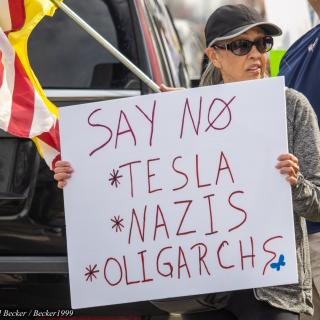The City and their special prosecutors ordered six Columbus police officers in March to identify fellow officers who (allegedly) committed criminal acts against Black Lives Matter protesters this past summer, but there’s no word yet whether they’ve complied.
In Minneapolis, however, the Blue wall of silence has begun to fissure.
Derrek Chauvin’s trial and murder conviction has shown that fellow officers don’t always have to protect “bad apples.” Minneapolis police veterans testifying said Chauvin’s actions against George Floyd were “totally unnecessary.” Minneapolis Police Chief Medaria Arradondo said George Floyd’s death was “murder.” Some are calling all of this “revolutionary.”.
But in our community the police appear to be remaining steadfast in not incriminating each other even though they have sworn an oath to put no one above the law.
There’s plenty of video evidence of alleged criminal acts by Columbus police against protesters this past summer, yet special prosecutors cannot identify those officers because they (allegedly) disguised their identity.
In what has been called a “last ditch” effort, the City is awaiting on whether these six officers will comply or potentially face departmental charges, even termination.
Special prosecutor Kathleen Garber and retired FBI agent Richard Wozniak have told local media a small number of officers other than these six agreed to be interviewed, but details were not given about what these few officers said.
Nonetheless, the number of officers refusing to talk or having memory lapses is far greater than those who may be helping. The Department of Public Safety in late March reported only five officers out of 60 have answered questions.
Their silence is earsplitting because the City, after pressure from the Division’s FOP, gave them the promise of Garrity. The 1967 US Supreme Court ruling which protects police from self-incrimination regarding criminal matters.
“Due to lack of cooperation, we haven’t been able to get the information we need to conclude these investigations,” special prosecutor Kathleen Garber told Channel 4 news recently. “I don’t think anyone envisioned that the investigation aspect of this would take so long.”
The Division has sworn to protect citizens no matter what, and some peaceful protesters this past summer were injured. There was one death but a coroner ruled the individual died from natural causes even though they had been exposed to tear gas.
During February’s federal civil rights protester trial, even former Chief of Police Thomas Quinlan sounded as if he was determined to stand behind the Blue wall.
During the trial plaintiff attorney John Marshall showed former Chief Quinlan a video where an officer approached a protester from behind. The officer snatches a gas mask off the protester’s face, and Quinlan eventually agreed with US Southern District of Ohio Judge Alegon L. Marbley the officer’s action was unwarranted.
Marshall then asked Quinlan: “As Chief of Police at the time, you had the authority to suspend any officer from duty. The officer in this video was not suspended, was he?”
Quinlan answered, “I don’t know who the officer is.”
The protester is arrested, and the video shows the officer fist-pumping other officers. The officer’s voice can be heard saying, “I took his mask off, I took his mask off!”
Marshall asked, “Chief do you recognize this officer? Do you see him grinning?”
Former Chief Quinlan: “I do not. It could be Sergeant [who will remain unnamed].”
Marshall asked, “You didn’t suspend any officers out of these protests?”
“None that I recall out of the protests,” answered Quinlan, who suggested to the court he may initiate an investigation into the officer who ripped off the gas mask.
Another attorney for the plaintiffs, Fred Gittes, told the Free Press they directly asked officers during cross examination whether a Blue wall of silence existed within the Division. Some denied it.
But more importantly, asked Gittes, were they aware of any officer who had reported on another officer who committed excessive force?
“Every ranking Division official we cross-examined, when asked if they could identify or remember a single example ever of an officer reporting excessive use of force by another officer, none of them could think of an example,” said Gittes. “These are people who have been on the Division for twenty or thirty years.”
To be clear, added Gittes, there have been some instances when officers have testified against other officers, but only when ordered to do so, for an investigation stemming from a civilian complaint, for example.
“The big difference is, the only person besides the victim who may have seen the excessive use of force was another officer. That’s a big difference,” said Gittes. “The point is, you collectively have high-ranking officers who have been with the Division for decades and they’re not aware of any [officers reporting on other officers].”
One City official during the trial agreed the Division has historically refused to police itself.
“The Mayor [Ginther] confirmed in his testimony that officers didn’t report other officers. And that a lot of officers feared retaliation and that’s why they didn’t report things. That’s in his testimony,” said Gittes.
It should be noted some rank-and-file officers have stepped out from the Division’s Blue wall to report on a fellow officer, but in a mind-boggling way that’s reflective of the Division’s soul.
In 2018 the Division’s chain of command sought termination of an African American commanding officer. This being Lt. Melissa McFadden, who has sought to reform the Division from within, her book Walking the Thin Black Linegiving extensive details of her efforts.
Lt. McFadden is the Division’s only commanding officer to ever be recommended for termination for alleged discrimination. Fellow officers came forward claiming she discriminated against white and black people.
In her book she wrote this was a stealthy effort by the chain of command to retaliate against her. The officers coerced into turning on her.
But it would fail, as the former Zone 2 second-shift lieutenant – covering the Southside and Far East among others – remains on the job after 20-plus years.
As everyone knows, the slurs used against an officer reporting on another officer is “snitch” or “rat.” Those Columbus police officers who have, were retaliated against. The Mayor is now admitting this.
If the Division over the decades had actively encouraged its officers to police themselves instead of abiding by some unwritten, not-so secret loyalty code would the community have a greater respect for its law enforcement?
It’s time for the Division to drop the toxic power-trip, the toxic masculinity, and get with the program.



